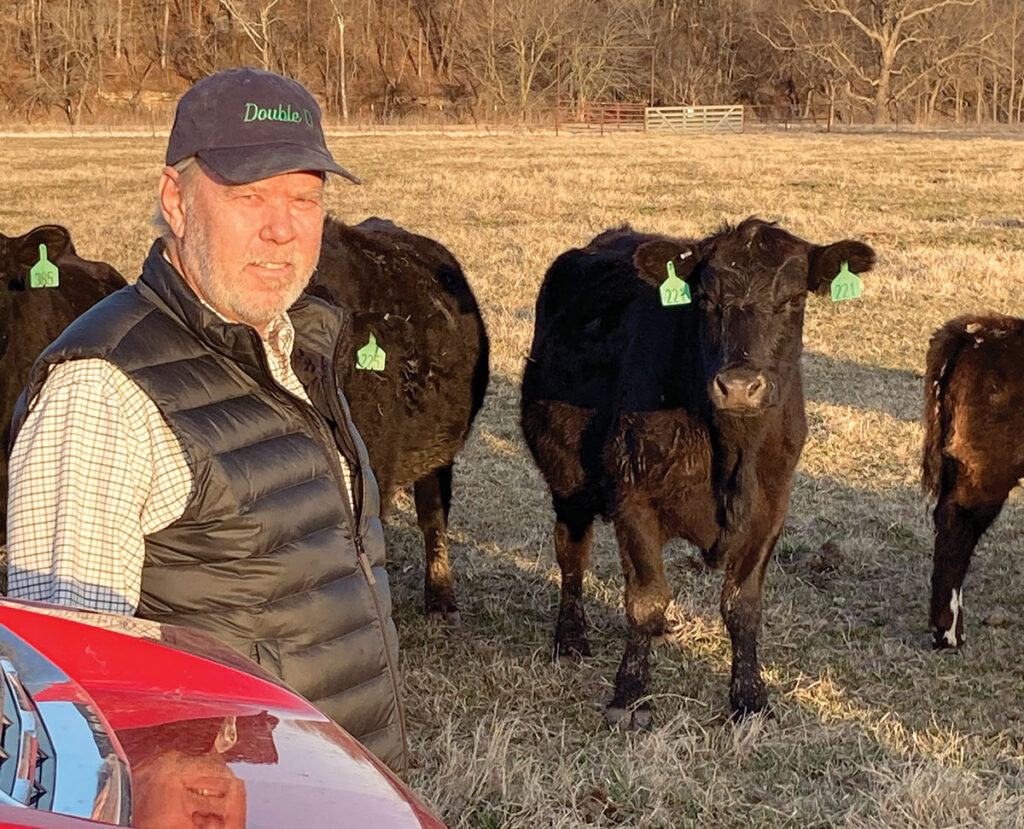
Dan Douglas continues farming on part of his family’s original 1853 homestead
Dan Douglas of Bentonville, Ark., was raised on a chicken and dairy farm. When he was a youngster, his parents, Max and Mabel Douglas, had a hatchery which included 60 incubators.
After serving on the quorum court for four years, Dan served as an Arkansas State Representative for eight years, where he served as chair of the House Ag, Forestry and Economic Development Committee for six years before deciding not to run again.
The years had been good ones, and Dan felt that he had accomplished what he needed to do. However, he grew tired of the political infighting and declined to run for reelection last year. He finds being able to listen to the feuding on TV a welcome relief from participating in it. One result of his political career was that fall calving became necessary in order to prevent a conflict with the Little Rock congressional sessions, which run from mid-January to mid-April.
“I could find help to feed and look over the cattle, but handling spring calving was another story,” Dan explained. “I didn’t want a utility room full of struggling calves when I couldn’t be there.”
Dan lives on 10 acres that was part of the family’s original acreage since 1853. Farming is in his blood and through the years he has been in agriculture in different places at different times. Five years ago, Dan purchased 200 acres just down the road from his home. Then, very recently, another farm he had been leasing was sold, resulting and all of his 120 commercial Angus cows run on limited acreage.
Dan plans on a herd of 80 females after heavy culling this spring. All of the females will be preg checked first, with any that are open culled and sold. Other culling criteria include age, feet condition and disposition.
“I’m too old to deal with crazy cows,” Dan commented.
Dan runs a black baldie operation and has four registered Hereford bulls that he switches out every four years to avoid linebreeding. While in the legislature, Dan did not raise replacement heifers but rather purchased young cows as replacements. Now that he’s back home, he’s planning on raising his own replacement heifers again.
The herd is worked twice a year, in spring and fall, using a good vaccination protocol and treating for flies, with mineral followed by pour on or spray as needed. The calves are weaned at 500 to 550 pounds when they are line weaned and retained for 30 to 45 days before being sold. Dan times weaning in order to allow cows three to four months to rest before the next breeding season.
From Dan’s viewpoint, the most important technological change since he was a youngster is the round baler. The larger bales reduced labor costs by making feeding and storage easier, decreasing cattle nutrition costs, in addition to being able to raise more cattle per acre.
Culling to 80 cows will leave land for hay meadows. Dan’s fields are mostly fescue and Bermuda, with little clover left after combating weeds like hemlock and Canadian thistle with the many years of successful spraying. On the other hand, Dan admits thistles can’t be entirely eliminated because the seeds are wind borne. He mixes herbicide and fertilizer for a one application process, another labor and cost saving practice. He spot sprays as needed. Part of Dan’s future plans is overseeding with clover and orchard grass.
Dan is deeply concerned about the future of agriculture and has discouraged his 15-year-old grandson Gauge from going into farming as a career. According to Dan, the population in 2050 is expected to be 10 billion people, which will require more food than has been produced in the previous 8,000 years combined. Science and modern production methods need to evolve in order to meet the huge need. Dan believes the movement toward plant-based meat does not take into account that cattle can be raised on marginal land that is unsuitable for crops. Just as the number of bushels per acre of corn keeps increasing through technology and science advancements, technology and science are going to have to be just as effective at increasing livestock production.
Another problem with the future of agriculture in general and livestock more specifically, from Dan’s point of view, is that making a profit, much less a living, is becoming more and more difficult due to rising input costs. He cites startup capital, equipment expenses, repairs, fertilizer and insurance as a few of many profit-stealing factors.
Dan loves taking his three grandchildren around the farm. While he enjoys taking them to the creek where they see ducks, herons and an occasional bald eagle, he also wants them to understand how much work is involved in agricultural production.
“I’m hard on the grandkids as they help me on the farm,” Dan said. “I want them to be hands-on with something other than a computer or cell phone. They need to get their hands dirty with the manual work that it takes to produce food in order to truly understand where their food comes from.”
One day, Gauge was helping Dan work cattle. Gauge was holding up the tail while Dan banded the calves. Once Gauge accidentally dropped the tail and Dan got kicked in the mouth and had blood running down his face. Gauge asked, “Are you alright, Grandpa?” I told Gauge that of course I was all right, and it was time to get another calf because there’s work to be done,” Dan said. “Got to teach these youngsters to work hard and be tough.”






